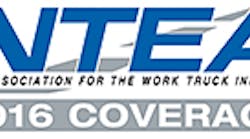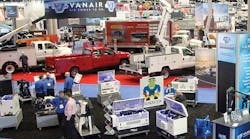THE proposed Phase 2 greenhouse gas (GHG) emissions and fuel-efficiency standards for medium- and heavy-duty vehicles should not force technology that customers are not requesting, and OEMs should be offered incentives to develop it if the customer wants it, according to Cynthia Williams, associate director of environmental and regulatory strategy for Ford Motor Company.
“It’s critical that we understand the customers’ needs in this segment,” she said. “If the customer would like an electric vehicle, they can come to a Ford. It’s critically important that you do not force this technology where customers are not requesting it. Offer incentives for manufacturers to build this type of technology if the consumers want it, but to force this type of technology, we don’t think this is the right approach. We’re willing to work with agencies to develop programs through an upfitter-type of program if a customer wants it.”
But Williams, speaking for Ford, General Motors, and Chrysler in a presentation, “Implications of Phase 2 Greenhouse Gas and Fuel Efficiency Regulations for Work Trucks,” said that doesn’t match up with what they are hearing from fleet operators.
“They say, ‘Look, we’re driven by return on investment,’ ” Williams said. “When we talk to our fleet operations, three years is considered aggressive, and in fact a one-year payback period is what they’re looking for. With new technology such as hybrid vehicles, there are multiple unknowns when it comes to fleet operations. There is driver behavior for types of different technologies. Unexpected maintenance costs and unexpected downtime are critical in this segment and need to be addressed and considered when you’re forcing different types of technology to enter this segment. Our customers say, ‘We need the tried and true. When I go out and start the vehicle, it needs to start and be able to perform the work I need for that day.’ ”
The EPA and NHTSA say the proposed Phase 2 program would cut GHG emissions by approximately one billion metric tons, conserve approximately 1.8 billion barrels of oil, and lower fuel costs by about $170 billion over the lifetime of the vehicles sold under the program, and “would also benefit consumers and businesses by reducing the costs for transporting goods while spurring innovation in the clean energy technology sector.”
The Phase 2 proposal responds to the President’s directive to develop new GHG and fuel efficiency standards for heavy-duty trucks that reach well into the next decade. The standards phase in over the long term beginning in model year 2021 and culminate in standards for model year 2027. Standards for trailers would start in 2018 for EPA and in 2021 for NHTSA.
The agencies say that “the long phase-in and incremental increases in stringency are designed to give industry time to ensure products are reliable and durable, and to provide long-term regulatory certainty,” but Williams believes it is not enough time.
“In addition to changes over the stringency, the year-over-year type requirements could be problematic for manufacturers,” Williams said. “The more flexibility we have built into the regulations, whether it’s an optional compliance path that as long as you get to the same goal at the end of 2027—we think those things should be considered as well.”
The agencies are proposing new, more stringent standards for the same classes of heavy-duty vehicles currently regulated through model 2018 and beyond under Phase 1. They are also proposing the first ever CO2 and fuel efficiency standards for certain trailers used with heavy-duty combination tractors. EPA’s proposed CO2 emissions standards and NHTSA’s proposed fuel consumption standards are tailored to each of four regulatory categories of heavy-duty vehicles: (1) combination tractors; (2) trailers pulled by combination tractors; (3) heavy-duty pickup trucks and vans; and (4) vocational vehicles that include all other heavy-duty vehicles such as buses, refuse trucks, and concrete mixers. The proposal also includes separate standards for the engines that power combination tractors and vocational vehicles.
In addition to the proposed standards, EPA and NHTSA are seeking comment on alternative standards that would accelerate the program by two to three years as well as several other alternative sets of standards, including less stringent and more stringent options.
The EPA and NHTSA say vocational vehicles represent about 20% of the total medium- and heavy-duty fuel consumption. The agencies are proposing new CO2 and fuel consumption standards for vocational vehicles starting in MY 2021, with increased stringency in MY 2024, and a fully phased-in stringency level in MY 2027. The proposed vocational vehicle standards are differentiated using three vehicle weights and three driving cycles. The agencies are also proposing separate standards for emergency vehicles.
The agencies say the fully phased-in standards would achieve up to 16% reduction in CO2 emissions and fuel consumption relative to Phase 1. The agencies project that the proposed vocational vehicle standards could be met through improvements in the engine, transmission, driveline, lower rolling resistance tires, workday idle reduction technologies, and weight reduction.
Heavy- and medium- duty pickup trucks and vans represent about 15% of the fuel consumption and GHG emissions from the heavy- and medium-duty vehicle sector. The agencies are proposing new CO2 emission and fuel consumption standards for heavy-duty pickups and vans that would be applied in largely the same manner as the Phase 1 standards. Under this approach, all manufacturers face the same standards, but the average emission and fuel consumption rates applicable to each manufacturer depend on the manufacturer’s sales mix, with higher capacity vehicles (payload and towing) having less stringent targets.
The proposed standards for this segment take the form of a set of target standard curves, based on a “work factor” that, as in Phase 1, combines a vehicle’s payload, towing capabilities, and whether or not it has 4-wheel drive. The proposed standards would become 2.5% more stringent every year from model years 2021 to 2027.
The agencies project that the proposed program would reduce CO2 emissions and fuel consumption for these vehicles by about 16% beyond Phase 1 when fully phased in.
“We believe most manufacturers would choose to meet the performance standards through increased use of the same technologies already being used to meet the 2014-2018 standards,” the agencies said last June. “These technologies include improvements in engines, transmissions, and lower rolling resistance tire technologies. Under Phase 2, the agencies expect newer, advanced technologies such as engine stop-start and powertrain hybridization will also become available in this segment of the market. These newer technologies are NOT mandated but some manufacturers may choose to use them to meet the standard. “
As with the Phase 1 program, the agencies are proposing separate standards and test cycles for tractor engines, vocational diesel engines, and vocational gasoline engines. For diesel engines, the proposed standards would begin in model year 2021 and phase in to MY 2027, with interim standards in MY 2024.
Because certain refrigerants are also extremely potent GHGs, the program includes EPA-proposed standards to control leakage of hydrofluorocarbons (HFCs) from air conditioning systems in vocational vehicles. Similar HFC standards already apply under the Phase 1 program for combination tractors, and for pickup trucks and vans. The EPA is also proposing more stringent nitrous oxide (N2O) standards for heavy-duty engines.
The proposed rule includes averaging, banking, and trading (ABT) compliance provisions for the engine and vehicle. The program would allow manufacturers to trade credits, bank credits for future years, and average credits. The agencies say this allows manufacturers to certify engines or vehicles that do not perform up to the standard and to offset them with engines or vehicles that perform better than the standard. ABT provisions allow manufacturers to balance market fluctuations impacting their sales volumes and projected compliance plans.
This program was established under Phase 1, and EPA and NHTSA are proposing to continue it with some minor revisions. The ABT flexibilities are designed to help increase the rate at which new technologies could be implemented, reduce the cost of compliance, and address potential lead time challenges in meeting the standards.
Williams said the regulatory rate of change must reflect the reality of the complex heavy-duty market, with fewer vehicle lines, multiple models, longer product cadence, and lower volumes to recover upfront capital and development costs.
“The ability to generate credits is limited based on the number of vehicles we have,” Williams said. “The heavy-duty market, the cadences for these vehicles, are not longer than light-duty vehicles. When we go out and speak, we want to make sure folks understand this is a totally different setting. These are work trucks. The regulations need to be structured so that these vehicles can continue to do the work that’s needed to move the economy.”
The proposed program fully harmonizes EPA and NHTSA standards. The agencies have worked closely with the State of California’s Air Resources Board in developing these proposed standards. All three agencies say they are committed to the final goal of a single national program that would allow manufacturers to continue to build a single fleet of vehicles and engines.
Michael Kastner, managing director of the National Truck Equipment Association (NTEA), said that cooperation is key.
“One of the hallmarks is the level of collaboration we’re attempting to maintain throughout the whole process,” he said. “Certainly this would be fully harmonized between EPA and NHTSA. We’re working closely with California to make sure they will be in a position to adopt Phase 2. Similarly with Canada. All three agencies in the US are committed to a single national program. That’s what we’re working hard to do now.”
The comment period closed April 1 and a final rule is expected in August. ♦












